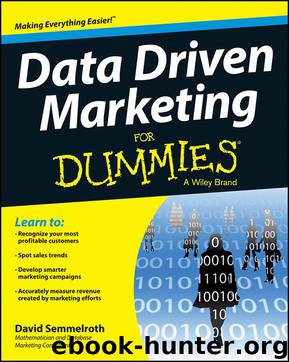Data Driven Marketing For Dummies by David Semmelroth

Author:David Semmelroth
Language: eng
Format: mobi, epub
Publisher: Wiley
Published: 2013-09-19T14:00:00+00:00
Chapter 11
From the Window to the Counter: Getting Shoppers to Buy
In This Chapter
Getting shoppers to identify themselves
Understanding your customers’ decision to purchase
Identifying purchase barriers
Re-contacting shoppers and overcoming barriers
Chapter 10 discusses ways you can protect and grow your relationship with your current customers. But you also need to find new customers. You can’t grow your business — in fact, you can’t even keep your business from shrinking — without a steady stream of new customers.
Many of your company’s marketing and advertising efforts are directed at increasing awareness of your brand and interest in your products. This means there’s a group of potential customers out there who are ready to begin a relationship with you. Many have gone so far as to actively investigate your product offerings. These are your hottest leads.
In this chapter, I use the term shopper to mean anyone who has shown an interest in your product. I talk about some ways to identify these potential customers. I also address some basic strategies for moving them from interested consumers to customers.
Identifying Shoppers
To execute database marketing campaigns targeted at shoppers, you need to know who they are. At a bare minimum, you need to have some sort of contact information — an e-mail address, phone number, or physical address, for example. You may know in great detail what potential customers are looking at on your website, but until you get them to identify themselves, you can’t communicate with them.
In this section, I explain a few approaches for getting anonymous shoppers to “raise their hands” and provide you with their contact information. In some cases, you can get customers to give you a great deal more information than that.
The information you can get from your shoppers ranges from just a simple e-mail address to a detailed description of their needs and interests. All the approaches I mention here boil down to one simple strategy: quid pro quo. Something for something. You need to give your shoppers something in return for the information you seek. That something doesn’t need to be financial. In fact, frequently an exchange of information is sufficient.
But you should be aware that even if a customer isn’t registered and logged into your website, you can still re-contact them. In Chapter 13, I talk in much more detail about marketing on the web. In particular, I discuss the notion of cookies — small files placed on a user’s machine to enable customization and tracking.
A common marketing technique is to place a tracking cookie on a user’s machine when they visit your website. When you buy advertising on other websites, you can ask those websites to look for that cookie and use it to serve up advertising content based on what the user was looking at on your website. This technique is called display re-targeting.
Put me on your mailing list: Getting customers to raise their hands
Suppose you’re in charge of customer acquisition for a catalog retailer. You have a limited marketing budget, which means you can only send a limited number of catalogs to prospects.
Download
Data Driven Marketing For Dummies by David Semmelroth.epub
This site does not store any files on its server. We only index and link to content provided by other sites. Please contact the content providers to delete copyright contents if any and email us, we'll remove relevant links or contents immediately.
Algorithms of the Intelligent Web by Haralambos Marmanis;Dmitry Babenko(16237)
Azure Data and AI Architect Handbook by Olivier Mertens & Breght Van Baelen(7676)
Building Statistical Models in Python by Huy Hoang Nguyen & Paul N Adams & Stuart J Miller(7658)
Serverless Machine Learning with Amazon Redshift ML by Debu Panda & Phil Bates & Bhanu Pittampally & Sumeet Joshi(7531)
Driving Data Quality with Data Contracts by Andrew Jones(7294)
Data Wrangling on AWS by Navnit Shukla | Sankar M | Sam Palani(7291)
Machine Learning Model Serving Patterns and Best Practices by Md Johirul Islam(7032)
Learning SQL by Alan Beaulieu(6239)
Weapons of Math Destruction by Cathy O'Neil(6220)
Big Data Analysis with Python by Ivan Marin(5937)
Data Engineering with dbt by Roberto Zagni(4933)
Solidity Programming Essentials by Ritesh Modi(4568)
Time Series Analysis with Python Cookbook by Tarek A. Atwan(4402)
Pandas Cookbook by Theodore Petrou(4088)
Blockchain Basics by Daniel Drescher(3544)
Natural Language Processing with Java Cookbook by Richard M. Reese(3146)
Hands-On Machine Learning for Algorithmic Trading by Stefan Jansen(3049)
Learn T-SQL Querying by Pam Lahoud & Pedro Lopes(2932)
Feature Store for Machine Learning by Jayanth Kumar M J(2928)
